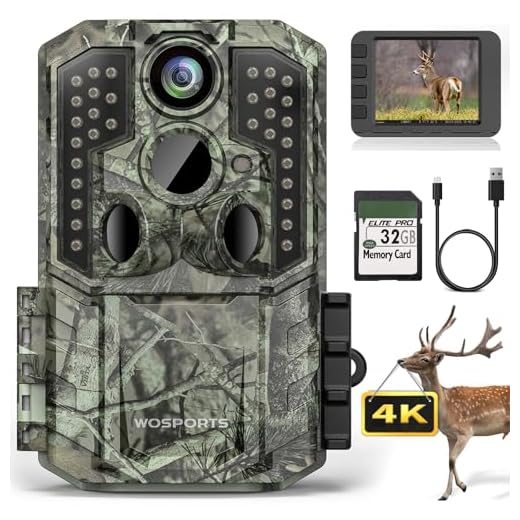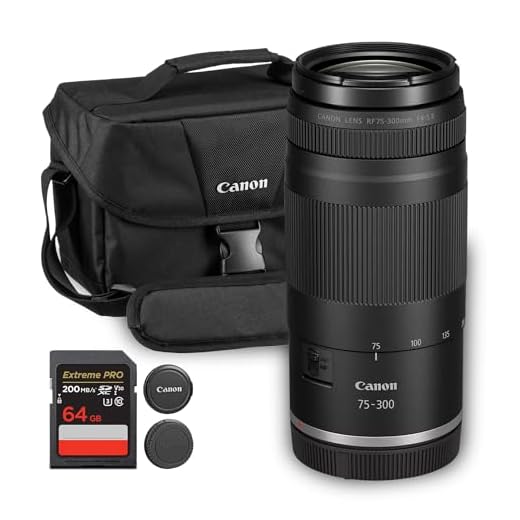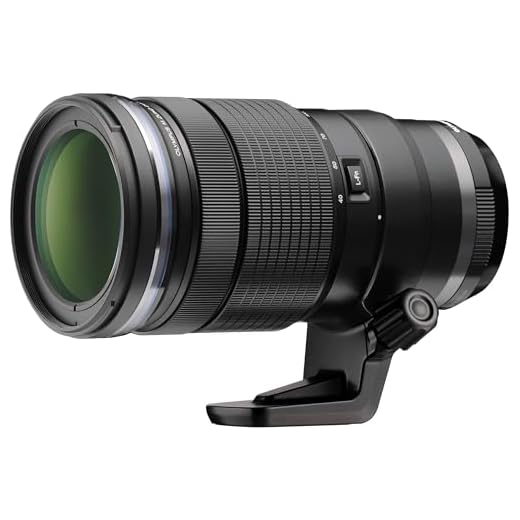



For those seeking the perfect equipment to capture the beauty of nature, I recommend focusing on a high-performance DSLR or mirrorless system paired with super-telephoto glass. The combination of fast autofocus, impressive low-light capabilities, and superior image stabilization is key to photographing elusive creatures in their natural habitats.
This article will guide aspiring and experienced shooters alike through a selection of exemplary equipment tailored for motion-heavy scenes. You’ll find detailed insights into specific models that excel in speed and image quality, ensuring that you nail those fleeting moments.
Expect recommendations spanning from robust camera bodies to versatile telephoto options, taking into account different budgets and styles. Whether you’re a beginner looking to make your first purchase or a seasoned traveler seeking to enhance your kit, the insights provided here will prove invaluable for your next adventure. Let’s get into the specifics!
Best Equipment for Wildlife Photography
Choosing a high-performance device is critical for capturing stunning images of nature. I recommend selecting a model that offers excellent autofocus capabilities and a fast frame rate. This ensures that I can seize fleeting moments of animal activity with clarity and precision.
An ideal option would have a large sensor, providing better image quality in various lighting conditions. This feature helps in getting detailed shots, even during early mornings or late evenings when wildlife is most active.
Recommended Features and Accessories
- High ISO Performance: Low-light capabilities are essential for capturing nocturnal creatures and environments with limited light.
- Continuous Shooting Mode: A higher frames per second rate supports capturing fast movements of animals in action.
- Weather Sealing: Protection against elements such as rain and dust allows for versatile shooting in different habitats.
- Ergonomic Design: A comfortable grip is important for long hours of shooting in the field.
When it comes to interchangeable optics, consider options with a long focal length. Telephoto choices are particularly advantageous, allowing for sharper close-up shots of distant wildlife without disturbance. A fast aperture will also aid in achieving a beautiful background blur, emphasizing the subject.
- Look for primes or zooms with 300mm or more focal length.
- Fast glass, ideally with f/2.8 or f/4, can provide excellent sharpness and low-light performance.
Utilizing a sturdy tripod or monopod can significantly enhance stability, especially with heavier lenses. A quality wildlife shooting setup not only promises great photographs but also enriches the experience of observing nature.
Evaluating Sensor Size Options for Wildlife Shoots
Choosing the appropriate sensor size significantly impacts image quality and performance in challenging environments. Full-frame sensors provide exceptional low-light capabilities, allowing for striking detail in dim conditions. In contrast, APS-C sensors offer a crop factor that effectively extends the reach of telephoto lenses, which can be advantageous when photographing distant subjects.
In situations where mobility and weight are considerations, micro four-thirds sensors can be compelling due to their lightweight and compact design. However, this often comes with a trade-off in depth of field and high ISO performance. The decision comes down to the specific requirements of the shoot, including the intended subjects and environments.
- Full-Frame Sensors: Ideal for low-light settings and achieving a shallow depth of field.
- APS-C Sensors: Effective crop factor allows for excellent reach with telephoto optics.
- Micro Four-Thirds Sensors: Lightweight and compact, making them ideal for long treks in the field.
Image quality is paramount when capturing elusive animals. Larger sensors generally outperform smaller ones in dynamic range and noise reduction, especially at higher ISO settings. When dealing with fast-moving subjects, a faster burst rate can also hinge on sensor size, providing more options for capturing that perfect moment.
| Sensor Size | Advantages | Disadvantages |
|---|---|---|
| Full-Frame | Superior low-light performance, excellent depth of field control | Heavier, more expensive |
| APS-C | Great reach with telephoto, lighter weight | Less effective in low light than full-frame |
| Micro Four-Thirds | Compact and light, often lower cost | Limited depth of field, performance disadvantages in low light |
I recommend testing different sensor sizes to find what complements your style and shooting conditions best. Consider the balance between portability and image quality as you refine your approach to capturing diverse wildlife. Each choice leads to unique results, shaping your experience and expertise in the field.
Telephoto Options for Capturing Distant Subjects
For those looking to photograph wildlife from afar, investing in a solid telephoto option is paramount. These lenses enable you to frame distant animals without disturbing them, allowing for intimate and natural captures. A longer focal length is ideal, as it provides the necessary reach while maintaining sharpness and detail.
When selecting a telephoto option, two key factors are aperture and stabilization. A wider aperture not only helps in low-light conditions but also creates pleasing background blur, isolating the subject. Image stabilization becomes critical in reducing motion blur, especially when handheld shooting at longer focal lengths.
Factors to Consider
- Focal Length: Opt for options ranging between 200mm and 600mm, depending on the distance typically encountered when shooting.
- Aperture: Aim for maximum apertures of f/2.8 or f/4 for better performance in varying lighting.
- Weight and Size: Consider portability, especially for long hikes or fieldwork, as heavier models may become cumbersome.
- Weather Sealing: Look for options that are resistant to moisture and dust, ensuring reliable use in various conditions.
- Compatibility: Ensure the selected piece works well with your current set-up, including any teleconverters if you plan to extend reach further.
Investing in a quality telephoto lens enhances the possibility of capturing stunning wildlife images even from significant distances. Prioritize those features that best meet individual needs, and enjoy the artistry of composing images that showcase the beauty of distant subjects in their natural habitat.
Choosing the Right Autofocus System for Quick Movements
For capturing rapid actions in animals, I prioritize systems that offer fast and accurate autofocus capabilities. Eye detection mode can be particularly beneficial, ensuring that I maintain focus on the subject’s eyes, even when they are in motion.
Continuous shooting modes are also necessary for wildlife movements. I find that a combination of phase-detection and contrast-detection autofocus works effectively to track subjects across varying distances and lighting conditions.
Key Features to Look For
- Tracking Sensitivity: The ability to adjust how quickly the autofocus system responds to a moving subject is critical. I prefer systems that allow fine-tuning to suit different situations.
- Focus Points: A system with a high number of focus points provides greater flexibility in composition and helps in tracking erratic movements.
- Lens Compatibility: Utilizing lenses with fast autofocus motors enhances performance during sudden movements.
In addition, I assess the autofocus performance in low-light settings, as wildlife often operates in such environments. A reliable autofocus system should maintain speed without sacrificing precision.
- Evaluate autofocus speed: Test how quickly the system locks onto a moving target.
- Consider multi-area mode: This feature enables tracking multiple subjects, allowing for spontaneous shots.
- Focus on custom settings: Customizing autofocus modes can cater to specific wildlife behaviors, providing an edge during unpredictable movements.
By selecting a robust autofocus system, I enhance my ability to capture the fleeting moments of wildlife activity, leading to striking imagery that conveys the energy and vitality of nature.
Essential Features to Look for in Weather-Resistant Gear
When choosing equipment for outdoor sessions in unpredictable climates, focusing on durability and protection is paramount. Weather-resistant features safeguard sensitive components from moisture, dust, and temperature changes, ensuring consistent performance in challenging environments.
A critical aspect to consider is the level of weather sealing provided. Gear with robust seals around buttons, compartments, and other vulnerable areas minimizes the ingress of water and particulates. This construction enhances reliability, particularly during prolonged exposure to rain or high humidity.
Key Features to Seek
- Water Resistance Rating: Check the IP (Ingress Protection) rating. A higher rating indicates better moisture protection. IPX6 and above generally ensure water resistance against splashes and brief immersions.
- Material Quality: Look for housings made from weatherproof plastics or magnesium alloys. These materials provide strength while reducing weight, crucial for carrying equipment over long distances.
- Temperature Tolerance: Verify the operational temperature range. Reliable gear should function in extreme temperatures without compromising performance.
- Lens Hood Compatibility: The ability to attach lens hoods can significantly protect against rain and snow. Some designs also include built-in hoods that enhance their resilience.
- Moisture-Repellent Coatings: Lenses with coatings designed to repel water and dust help maintain image clarity and reduce cleaning time in adverse weather conditions.
Picking the right equipment with these features not only enhances my experience but also improves the quality of my shots. Adapting to environmental challenges becomes easier when the gear is built to withstand them.
Budget-Friendly Camera Choices for Aspiring Wildlife Photographers
For those looking to explore the world of animals through an affordable lens, it’s crucial to find options that balance quality and price. The right equipment can make a significant difference, allowing anyone to capture stunning moments without breaking the bank.
When considering a good setup, I suggest focusing on features that enhance your experience. Look for models equipped with fast autofocus systems, which are invaluable when trying to capture swift movements. A decent burst shooting mode is equally important, as it allows multiple shots in quick succession, increasing the chances of getting that perfect shot.
Key Features to Consider
- Sensor Size: Larger sensors can provide better image quality, especially in low light. A well-sized sensor is beneficial for shooting in various environments.
- ISO Performance: Good low-light performance is necessary for dawn or dusk photography when many animals are active.
- Weight: A lighter setup is easier to handle during long excursions; consider equipment that won’t weigh you down.
- Durability: Weather-resistant bodies can withstand outdoor conditions, proving essential during unpredictable weather.
In addition to the body, choosing a versatile zoom option is advisable. A long-reaching telephoto option can enhance your ability to get close to wildlife without disturbing them. Look for alternatives that offer a wide aperture, improving performance in varying light situations.
Finally, don’t overlook the importance of user-friendly interfaces. Intuitive controls will allow for quicker adjustments, enabling one to focus on the subject rather than the settings.
With the right approach, even budget-friendly equipment can yield fantastic results in capturing the beauty of nature.
Comparing Prime and Zoom Lenses for Versatility in the Field
For a wildlife enthusiast, the choice between fixed-focus and variable focal-length objectives significantly influences shooting experience and image quality. I often gravitate towards specific applications that inform my choice, weighing the benefits of each type based on situational demands.
Fixed-focus options usually excel in image quality thanks to larger maximum apertures, which enable better performance in low-light conditions. However, the adaptability of zoom types provides versatility essential for unpredictable environments where subjects may not always be at a consistent distance.
Prime characteristics include:
- Improved sharpness and contrast.
- Larger apertures for better light gathering.
- Typically lighter and more compact.
Zoom benefits comprise:
- Flexibility to capture subjects at varying distances.
- Reduced need to switch gear, minimizing missed opportunities.
- Convenience of varied focal lengths in a single unit.
In my experience, if your focus is primarily on high-quality portraits of stationary animals, fixed-focus models prove invaluable. Conversely, if you’re encountering dynamic wildlife encounters, a variable focal-length model allows for quick adjustments without compromising the moment.
| Factor | Fixed-Focus | Variable Focal-Length |
|---|---|---|
| Image Quality | High | Good |
| Aperture Size | Larger | Usually smaller |
| Weight | Lighter | Bulkier |
| Versatility | Limited | Highly versatile |
Ultimately, selecting between these options boils down to your style and the scenarios you anticipate in the field. For maximum functionality, I often keep one of each type in my kit, allowing me to adapt to any unfolding scene with ease.
Best camera and lenses for wildlife photography
Features
| Part Number | JT-420cn |
| Model | 420-800mm super telephoto lens |
| Warranty | 1 year warranty |
| Color | black |
Features
| Part Number | G600 trail camera |
| Model | G600-4K |
| Color | Light Green |
| Size | 1 Count (Pack of 1) |
Features
| Part Number | SEL70350G |
| Model | SEL70350G |
| Warranty | 1 year manufacturer |
| Color | Black |
| Release Date | 2019-11-01T00:00:01Z |
Features
| Part Number | 6263C002 |
| Model | 6263C002 |
| Warranty | 1 year manufacturer |
| Color | White |
| Release Date | 2023-12-14T00:00:01Z |
Features
| Part Number | 7155C002_EDIP_1 |
| Model | 7155C002_EDIP_1 |
Features
| Part Number | V315050BU000 |
| Model | V315050BU000 |
| Warranty | 1 year coverage for parts |
| Color | Black |
| Release Date | 2014-12-11T00:00:01Z |
FAQ:
What types of cameras are considered best for wildlife photography?
The best cameras for wildlife photography typically feature fast autofocus systems, high frame rates, and excellent low-light performance. Mirrorless cameras like the Sony A7R series or the Canon EOS R series are popular choices due to their compact size and advanced technology. DSLRs, such as the Nikon D500 or Canon EOS-1D X Mark III, are also favored for their durability and extensive lens options. Wildlife photographers often prioritize cameras with high sensor resolutions for capturing detailed images of distant subjects.
Which lenses are recommended for capturing wildlife imagery?
For wildlife photography, telephoto lenses are essential for getting close-up shots without disturbing the animals. Lenses in the range of 300mm to 600mm are commonly used. The Canon EF 100-400mm f/4.5-5.6L IS II and the Nikon 200-500mm f/5.6E VR are excellent choices, as they provide versatility and sharp images. Additionally, prime lenses, such as the Canon EF 500mm f/4L or the Nikon 600mm f/4E FL, offer superior image quality and performance in low light, albeit at a higher cost and weight.
How important is image stabilization in wildlife photography gear?
Image stabilization (IS) is highly beneficial in wildlife photography as it helps reduce the effects of camera shake, especially when using long focal lengths. This technology is crucial for handheld shooting, allowing photographers to capture sharp images at slower shutter speeds. Many modern lenses, both zoom and prime, incorporate IS features, and some camera bodies also offer in-body stabilization. This can significantly enhance the ability to photograph moving subjects in various lighting conditions.
What should photographers consider when choosing wildlife photography equipment?
Photographers should consider factors such as weight and portability, especially for those who trek into remote areas. The weather-sealing of the camera and lens is also important, as wildlife photography often takes place in unpredictable environments. Additionally, autofocus speed and accuracy are critical for capturing fleeting moments. Budget constraints can influence choices, so it’s essential to balance quality and performance with cost to find the right gear that meets individual needs.
Are there specific accessories that enhance wildlife photography?
Yes, several accessories can enhance wildlife photography. A sturdy tripod or monopod is often essential for stabilizing long lenses. A camera backpack designed for outdoor use can help organize and protect gear. Additionally, using a remote shutter release can minimize camera shake during long exposures. A lens hood helps reduce lens flare, and polarizing filters can dramatically improve the richness of colors and contrast in your images, especially in bright environments. Each of these accessories contributes to capturing better wildlife shots.









